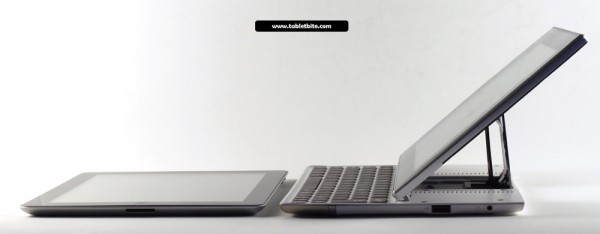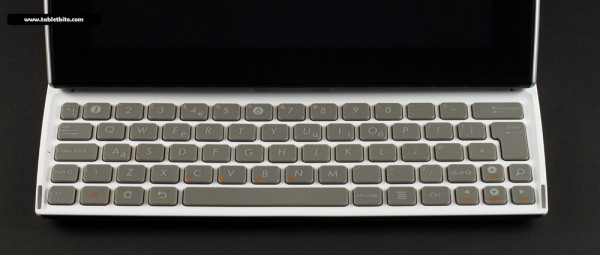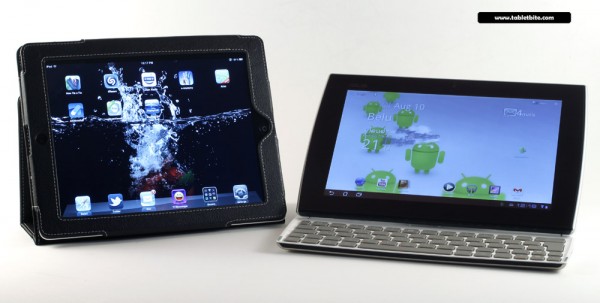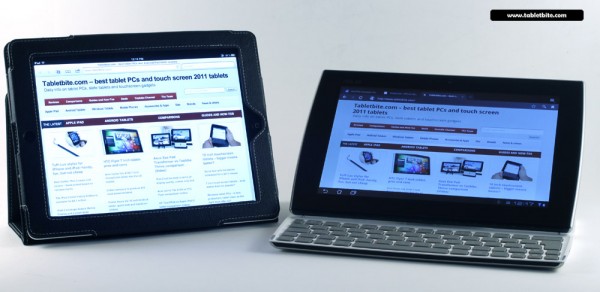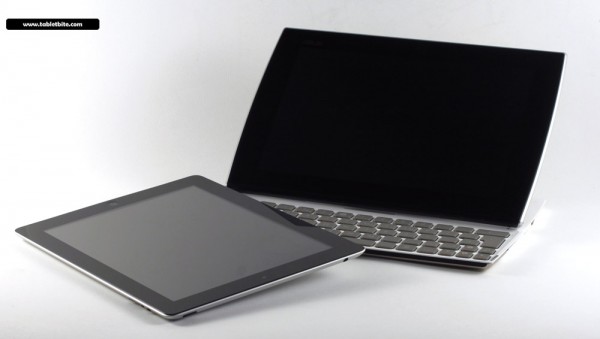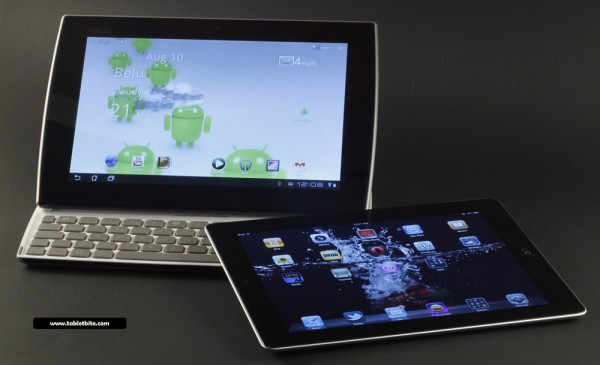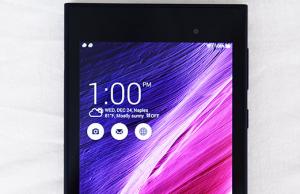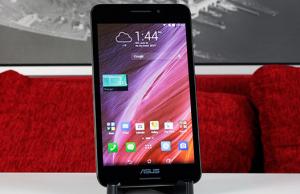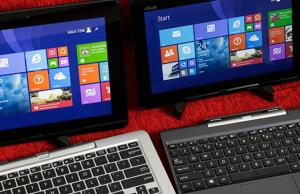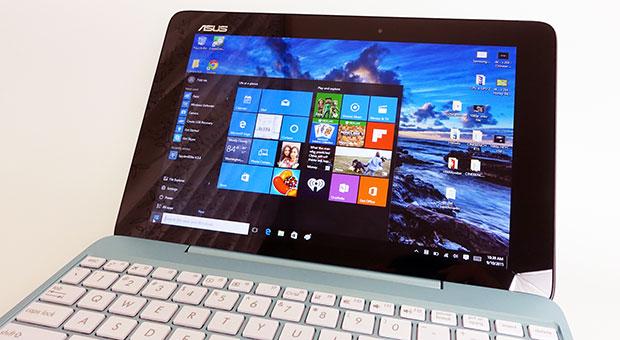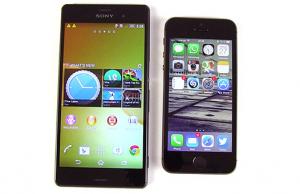From starters, this might seem like a wrong comparison, as the Apple iPad 2 and the Asus EEE Pad Slider are pretty much different types of tablets. However, since they both compete on the same market, our post should help you decide which one is better for you than the other.
Of course, the two tablets target theoretically different categories of users. The iPad is as light and as compact as possible, but lacks most of the ports you would love to have on a tablet, while the Slider is significantly bulkier and heavier, but offers those and also a keyboard.
Thus, from starters, I’ll tell you that the iPad is the better choice if you want a tablet for fun, gaming and leisure time. On the other hand, the Slider will offer all those (to a limit though), but add productivity, thus it’s the better option for those that need a tablet they can also work on.
For more details, see the rest of this post.
Body and design
In terms of exterior and body, these two tablets couldn’t be more apart.
The iPad weighs significantly less than the Slider (1.33 lbs vs 1.95 lbs – 613 g vs 886 g) and it’s also half its height (0.34″ vs 0.7″, 8.8 mm vs 17.7 mm), and you’ll feel these when carrying the tablets around. While you can hold the iPad with one hand and use it with the other (you’ll still feel the weight after a while though), the Slider is more of a tablet you’ll use while sitting down, probably on a desk or on your lap, like you usually do with laptops.
When in slate mode, the EEE Pad feels comfortable in your hand; in fact, i find it more comfortable to hold with both hands than the iPad (I hate the sharp edges on the Apple tablet, thus I never use it without a case), but that extra weight will get your arms tired quite fast.
They are also different in terms of the materials used for the casing. The iPad is made from aluminum, which looks solid but is also quite slippery. I for one for instance can’t use my iPad without its case because of that as well. On the other hand, the EEE Pad is made from plastic and combines matte surfaces with glossy and chromed ones. Of course, plastic ain’t as solid as aluminum, but the overall result looks very appealing in my eyes.
As a conclusion, the iPad is slimmer, lighter and feels more solid, but the Slider ain’t bad looking or flimsy built either, so it will be a nice pick as long as you don’t mind the extra bulk.
Connectivity and ports
Both feature all the needed sensors (accelerometer, g-sensor, gyroscope, compass, light-sensor) and connectivity options, with Bluetooth (but you know of course iPad’s Bluetooth is only limited to a bunch of functions, like connecting some, not all, headphones), GPS and Wireless N. The iPad also offers 3G on some versions, while a 3G Slider will also be available by late Fall 2011.
In terms of ports though, the Slider kicks iPad’s behind. While on Apple’s tablet you get only a proprietary port for charging/docking/extension modules and a 3.5 mm jack, the Slider offers as well a microSDHC card slot, mini HDMI port (Type C) and a ful-size USB 2.0 port you can use to connect a bunch of different accessories, like memory sticks, external hard-drives or a mouse.
Keyboard
Like I told you before, there’s a sliding keyboard on the Asus EEE Pad. It’s not a full-sized one and keys are a bit small, as while the keyboard is pretty much similar to what you find on netbooks in terms of length, it’s a lot narrower, with rectangular keys, not square ones like you get on most keyboards.
There are also some small layout problems, like an awkwardly small Left Shift key, and some obvious flex, but once you’ll get used to these problems you will enjoy the keyboard for your daily writings. Still, if you desperately need a keyboard on a tablet, I would suggest going for a Transformer and a docking station. See our Slider vs Transformer comparison for more details.
As for the on-screen keyboard, I prefer the one on the iPad, as it comes with a better designed layout in my eyes, but that might be just because I got used to it. The virtual keyboard on the Asus Pad comes with an extra row of numbers on top of the keys and you will probably appreciate that, but it makes it rather tall and a bit cramped. Plus, Forward and BackSpace buttons are horridly placed in my opinion, in the lower right corner, instead of the upper right one like on 99% of all keyboards out there, virtual or physical.
Display
There’s a 9.7 inch display on the iPad and a 10.1 inch one on the Slider. However, the one on Apple’s tablet comes with a 4:3 format and 1024 x 768 px resolution, while the one on the Asus device offers a 16:10 aspect ratio and 1280 x 800 px resolution. This comes with pros and cons for both parties. The EEE Pad is better suited for video content, as its screen is optimized for these new wide-format movies and also offers better resolution, so there’s a bigger workspace to play with.
On the other hand, I consider that the 4:3 aspect ration used on the iPad makes it more versatile for portrait use and will be quite handy when trying to type (i use it like this). Also, on landscape mode, when activating the on-screen keyboard, it will almost completely cover the display on the Android tablet, while on the iPad it actually leaves room for other stuff on top.
As for the smaller resolution, it theoretically helps the iPad perform faster, as there’s less info for the hardware to process than there would be on an increased one. And while i’m sure I’d like an increased resolution, I am really not bothered by the one currently available on the iPad, especially since most apps are optimized to use the most out of it.
And there’s one more thing: both these screens feature an IPS panel, thus are bright and offer excellent viewing angles and colors (although these last ones are a bit more lively on the iPad). Also, they are covered in Gorilla glass for protection, thus they are extra glossy and an absolute pain to use outside, in strong light.
Hardware
Theoretically, both these tablets feature similar hardware: the iPad is built on an Apple A5 platform, while the Slider on a Tegra 2 one, but the two are actually iterations of the same ARM processor. On the other hand, the Slider features 1 GB of memory, while the iPad 2 features half the amount, only 512 MB.
Thus, you would expect the iPad to be slower, but it’s not actually. In most tests and benchmarks the iPad scores higher than Tegra 2 tablets in terms of both CPU and GPU performances. And that’s mainly because the hardware+software synergy is way superior on the Apple tablet, as the OS was specifically designed to maximize the capabilities of the hardware inside, while the Android + Tegra 2 combo still has many leaks to fix.
Software and apps
The Asus EEE Pad Slider runs Android HoneyComb (we got Android 3.1 on our test unit), while on the iPad 2 we got iOS (4.3.3 on ours). There are many many things that set the two apart and I’m not going to get into details here, we have other posts the speak about this in detail.
Basically though, iOS is a simple operating system, even rudimentary some may call it, but one that will be fast and reliable during everyday use. You can’t really customize it, it doesn’t support multitasking and it features an awkward notification system, but it is also stable and won’t get sluggish under load. Android allows all those tweaks but it’s also a bit less intuitive for the average Joe, plus it will sometimes get buggy, sluggish or will freeze altogether. Yes, it is true it has gotten more reliable with v3.1, but there are still issues to be fixed.
And there’s also the apps matter. Android offers some excellent basic apps, like Youtube HD, email client, Google maps and browser, mainly the apps specifically designed for HoneyComb and made by Google. All these are better than their counterparts on the iPad 2, especially the browser and the email app.
However, when it comes to the market and 3rd party apps, there’s a completely different story to tell. First, it’s really complicated to find apps designed for tablets and their big displays in Android Market (as they are not separated in any way from the apps built for phones), not to mention that many areas are still poorly covered. For instance, as an avid Twitter user, I’ve been struggling to find a decent one for HoneyComb and I had to settle for TweetComb in the end, but it’s still light years behind the official Twitter app available for iOS. And that’s only one example.
The AppStore is way more easy to use and more intuitive, apps are divided between iPad and iPhone ones, you can install and buy them easily if you need to, you can easily upgrade them (all at a time, not individually like on Honeycomb) and you get way more (and way better ones) to choose from.
Multimedia and games
The Slider is a slightly better tablet for watching video content, mainly because it boosts the 16:10 aspect ratio screen, but also because it supports more types of clips and video files. Now, Tegra 2 does not officially offer H.264 hardware decoding, thus you will have problems playing Full HD content on the Slider. In fact, the native movie playing app won’t even deal with such type of content, but you can run it with 3rd party apps like MoboPlayer or DicePlayer, although you will get sluggish performances and skipped frames. 720p content though works fine in most cases, while there are exceptions with some .mkv files.
As for the iPad, you know that you’ll need iTunes to add content on it and it will simply not allow you to add files that are not supported. Thus, it’s better to stick with .mov clips, which will play flawlessly even at 720p. 1080p content though is not supported on the iPad 2, so such clips will not be even copied on your device.
Of course, both can handle with ease HD Flash content from Youtube and some other sites (but remember that the iPad does not support Flash, so will only be able to play content from HTML5 compliant streaming sources).
As for games, I consider the iPad 2 the better pick for such type of content, mainly because games designed for this tablet are better looking and better optimized. Plus, you get way more titles to choose from. On the Asus Slider, and all Android tablets in fact, you’ll hardly find any proper games except for the couple of dozens available in TegraZone. And even the ones available for a multitude of platforms are poorer optimized for Android, including big names like GunBros or Pocket Legends.
Cameras
Not sure how much you would use the cameras on these, as they both offer mediocre to medium results actually (but that’s actually the case with all tablets on the market these days). Still, the 5 MPx camera on the Slider is significantly better than the one on the iPad, despite tending to overexpose pics. The iPad however tends to over-saturate shots and comes with way poorer resolution (below 1 MPx).
On both you can find front-facing cameras for video-calls or chatting/skyping and both these tablets can shoot 720p content, but don’t expect too much in terms of quality.
Speakers
The Slider offers stereo speakers, while the iPad has a single mono speaker. In terms of sound quality thus, I would lean towards the solution on the Asus tablet.
However, the speakers on the Slider offer poor volume, as opposed to the one on the iPad which is quite loud. Plus, being placed towards the back on the EEE Pad, near the sliding mechanism, means they will be obstructed by the screen when you’ll use the device in slate mode, and this will decrease overall volume even more.
Battery life
You can expect around 10 hours of life on your iPad during everyday use, with browsing, watching video content, listening to music, playing some games,etc.
The Slider on the other hand will offer a bit less in similar conditions, around 7 to 7 and a half hours, which is still good enough for a full-day’s work, but pales when compared to what the Apple tablet can deliver.
Prices and availability
The iPad starts a $499 for the 16 GB Wi-Fi only version and prices rise quickly as you get more storage (up to 64 GB) or 3G.
The Slider is not yet available in stores, but based on our sources, it should be by mid September and it will go for around 550 bucks for a 32 GB Wi-fi only version. A future 3G Slider will follow by late Fall.
Thus, the Slider will in fact be cheaper than the similar 32GB Wi-fi only iPad, that goes for $599.
Video comparison
More details about the two are available in the video comparison below.
Wrap up
In the end, it’s obvious that each of these two devices comes with its pros and cons.
The iPad is more compact and lighter, plus a bit more solid built. It benefits from an overall more stable operating system, thus your everyday experience should be better with it, plus it has access to throngs of apps specially designed and built for its hardware and screen. It is however a bit more expensive than a matching Slider.
The Asus tablet is significantly thicker and heavier, but it offers a physical keyboard and a bunch of ports and features you’ll love, like that microSD card slot and the miniHDMI and full-size USB 2.0 ports. It runs Android, which is a bit more unstable than iOS, but we’ve seen solid progress lately from Google towards making their operating system more reliable. It still is more customizable than iOS, allowing you to tweak it up to your needs, but it may seem too complicated for the average user, plus it lacks the army of games and apps optimized for big screen devices that you’ll find on the iPad.
All in all, both these ones are solid picks, but they are designed for different kinds of users: the iPad is more of a fancy toy for your free time, while the Slider manages to offer some extra productivity that will be much appreciated when trying to use your tablet for work.
That’s about it for now, but I’m really looking forward to see your input, so please go ahead and leave your replies and opinions below.



